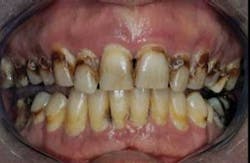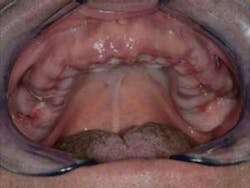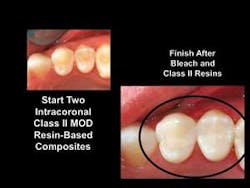Gordon J. Christensen, DDS, MSD, PhD
In this monthly feature, Dr. Gordon Christensen addresses the most frequently asked questions from Dental Economics® readers. If you would like to submit a question to Dr. Christensen, please send an email to [email protected].
For more on this topic, go to www.dentaleconomics.com and search using the following key words: bad breath, tongue cleaners, tongue debris, caries, Dr. Gordon Christensen.
Q I’ve heard various opinions on the necessity for tongue cleaning. Often, I see extremely coated tongues with green, brown, yellow, and even black debris on the surface. On the other hand, many people have a completely clean and pink tongue. What is the significance of this debris on the tongue? What is the best way to remove it? How often should it be removed? Does it influence caries and periodontal disease? Are young patients immune from debris on their tongues?The concept of tongue cleaning is not new. Tongue cleaning was practiced among wealthy and elite people in various parts of the world for centuries. There are examples of elaborate and ornate tongue cleaners (scrapers) that have been found dating back centuries.
Unfortunately, modern dentistry has somewhat overlooked the importance of tongue cleanliness. There is no question that dentists and dental hygienists look very carefully at debris on the teeth, and advise patients how to clean their teeth. However, dental practitioners do not often discuss the necessity of cleaning the tongue. Some dentists instruct patients to use a toothbrush for tongue cleaning, but this has been shown to be inadequate.
I will answer your questions about tongue cleaning and add information about the desirability of tongue cleaning.
Are there reasons to clean the tongue?
One of the most important reasons for tongue cleaning on a day-to-day basis is bad breath. All of us back away from people who have bad breath when we have a conversation with them. The fetid odor that comes from their mouth during speaking or breathing is offensive. What causes bad breath?
Many things have been identified. These include deep crevices in the tongue that contain microorganisms and plaque, periodontal disease, infected adenoids, gastrointestinal problems, postnasal drip, dry mouth, thrush, eating odoriferous foods such as onions or garlic, and more. However, it has been estimated in numerous studies that up to 90% of halitosis comes from the mouth and about 80% comes from tongue debris.
The following tip is for everybody, whether they have a coating on their tongue or not. Everyone eats smelly foods from time to time. Afterwards, most of us sense that our breath is bad because of the lingering foul taste in our mouth. However, some people don’t realize they have bad breath.
If the tongue is cleaned after eating such foods, the bad odor can be greatly reduced or eliminated. I suggest that after eating smelly foods, patients should be advised to clean their tongue as far down the throat as they can comfortably reach with a tongue scraper. The bad odors are easily reduced. You may see how much debris remains on the tongue after eating by doing a simple test.
After eating chocolate or other highly pigmented foods, clean your teeth in the normal manner. This oral hygiene task is all that most people accomplish after eating. Now with an effective tongue scraper, scrape your tongue. You will be amazed at how much color comes off the tongue.
You will have to scrape the tongue several times before all of the pigment is removed. You will be amazed to see how much debris remains. If you do not scrape your tongue, the debris remains for many hours after eating, putrefies, and causes a disagreeable odor. In my opinion, cleaning the tongue after eating smelly, sticky, or greasy foods should be a routine oral hygiene activity, just as necessary as using deodorant or taking a shower.
Are there more serious consequences related to leaving debris on the tongue?
All dental clinicians are very concerned about preventing two oral disease conditions that directly relate to this topic. Dental caries and periodontal disease are both infectious diseases that depend on the presence of oral microorganisms. There are also potential systemic implications. The presence of periodontal disease has been related to diabetes, coronary artery disease, and stroke. The tongue provides a major source of organisms for these local diseases and may potentially have overall systemic effects.
You know how thoroughly most dental clinicians advise their patients to clean their teeth to help prevent dental caries. After dental hygienists observe the thoroughness with which patients clean their teeth, many use colored disclosing solutions to show them the remaining dental plaque. Patients are then shown how to meticulously clean every small amount of plaque from the teeth.
Yet seldom do we oral health practitioners continue the oral hygiene instruction to include the tongue. Resting on the tongue and usually untouched in an oral hygiene appointment are far more organisms than on the teeth. Where do you think some of these organisms go immediately after the professional tooth cleaning? You guessed it — to the teeth and periodontium, thereby reinfecting these sites in seconds.
I hope I have opened your eyes to our incompleteness in oral hygiene procedures. Omitting tongue cleaning during an oral hygiene procedure is similar to cleaning and washing only the roof of a car and leaving the fenders and doors untouched. Tongue cleaning is essential for thorough oral hygiene and optinum oral home care.
Do all patients routinely have significant debris on their tongue?
As you become more aware of the disease-causing potential of the organisms on the tongue, I suggest that you start looking more thoroughly at the tongue when you do your normal oral cancer exam (Figs. 2 and 3). Most dentists or dental hygienists are able to grasp the tongue and pull it out of the mouth as far as it will go without discomfort.
If your practice is a typical general practice with all ages represented, I’ve noticed that during this tongue observation, about 50% of patients will have a thick layer of scum on their tongues.
Show the tongue to patients as you do the exam and explain that the colorful layer is organisms and their excretions. Although somewhat disagreeable to discuss, the visual observation of the debris on the tongue will motivate patients to clean it.
Removing the oral debris on a routine basis cleans and exposes the taste buds, potentially increasing taste perception.
Additionally, there is a psychological advantage to cleaning the tongue. The person feels that their mouth is clean and the odor is gone.
How should you clean your tongue?
When asked if they clean their tongue, some patients say that they brush their tongue with a standard toothbrush. Is that method of tongue cleaning adequate? No, it is not! Studies have shown that merely brushing the tongue removes only a small amount of debris.
The most advisable method to clean the debris is with a tongue scraper. It has been shown that bacterial counts on the tongue can be reduced as much as 50% after only one day of effective tongue hygiene. The taste buds in some people provide a surface much like a shag carpet. When they’re coated with debris, the organisms reside there in great quantities.
Fig. 4 — Although there are many brands of tongue scrapers on the market, a highly rated one is the Oolitt tongue scraper (813-909-0058
www.oolitt.com or from Henry Schein). It is a popular and accepted brand that comes in both adult and child sizes.
Many simple tongue cleaners (scrapers) are readily available on the market. They are available in various materials, including metal and plastic. They vary in width, ranging from about one-half the width of an average adult tongue to wide enough to scrape the entire width of the tongue.
Some have irregularities on their scraping surfaces, and some are smooth. Most tongue scrapers are relatively inexpensive and serve for a long time before breaking.
Of course, personal preferences determine what type of tongue scraper a patient prefers. I prefer plastic tongue scrapers that provide some flexibility, are not quite as wide as an average tongue, and with slight irregularities on the scraping edge. These rippled edges provide a raking effect as they gently scrape across the tongue. A typical example of such a scraper is shown in Fig. 4.
Children are not immune from having organisms on their tongues. I’m sure you’ve seen children with significant debris on their tongues. Initiating tongue cleaning at an early age makes children aware of the desirability of cleaning the tongue. Leaving debris on the tongues of children potentially contributes to dental caries, gingivitis, and foul breath, just as in adults.
It’s been shown that dental carious lesions are present in nearly half of children by age five. Brushing teeth reduces some mouth odor, while tongue cleaning has the potential to reduce mouth odor much more effectively.
There is a tendency to gag if a scraper is placed too far down the throat when first using a tongue scraper. I suggest opening the mouth wide and fully extending the tongue.
Then place the scraper as far down the throat as is comfortable the first time and progressively go farther during subsequent cleanings. Use gentle strokes. You will eventually be able to place the scraper far down the throat without eliciting the gag reflex. Thorough tongue cleaning requires only a few seconds.
How much force should be placed on the scraper?
This varies from person to person. I suggest placing just enough force on the scraper to feel slightly uncomfortable. If too much force is placed on the scraper, the tongue will become injured and bleed. If too little force is applied the tongue will not be cleaned well.
If the scraper is not as wide as the tongue, which is often the case, then several scrapings should be varied from left to right to reach the entire width of the tongue as far into the mouth as is comfortable. After a few times scraping, most people have no trouble doing a thorough tongue cleaning. The scraping should be continued until there is no more visible debris, and only clear liquid is observable when the scraping is done.
I assure you that as this procedure becomes part of a daily oral hygiene routine, patients will realize that not accomplishing tongue scraping is objectionable (Fig. 5). When your patients begin tongue cleaning on a routine basis, you will notice a significant difference on their next visit to your office.
To summarize my answers:
The significance of the debris on the tongue is enormous and very negative. The debris can be removed very easily with a simple tongue scraper. The debris should be removed daily or as often as it accumulates.
Yes, the organism accumulation on the tongue has significant potential to contribute to ongoing dental caries and periodontal disease, and can potentially influence systemic health.
Practical Clinical Courses (PCC) has a video on Minimally Invasive Periodontal Therapy (Item #V4323) that includes tongue cleaning as one of the significant conservative methods that can help reduce periodontal disease. Patients appreciate being given conservative treatment alternatives to typical periodontal surgery.
Additionally, PCC has a series of nine-minute patient educational videos on most of the subjects in dentistry, including oral hygiene (Item #DP7).
Dr. Christensen is a practicing prosthodontist in Provo, Utah. He is the founder and director of Practical Clinical Courses, an international continuing-education organization initiated in 1981 for dental professionals. Dr. Christensen is a cofounder (with his wife, Rella) and senior consultant of CLINICIANS REPORT (formerly Clinical Research Associates), which since 1976 has conducted research in all areas of dentistry.
More DE ArticlesPast DE Issues









